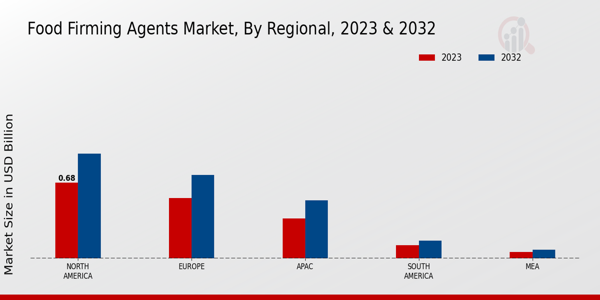Market Trends and Projections
The Global Food Firming Agents Market Industry is characterized by dynamic trends and projections that shape its future landscape. Current data indicates a market value of 1.8 USD Billion in 2024, with expectations of reaching 2.81 USD Billion by 2035. The compound annual growth rate (CAGR) of 4.15% from 2025 to 2035 suggests a steady increase in demand for firming agents across various food applications. This growth trajectory is influenced by factors such as consumer preferences for healthier options, advancements in food processing technology, and regulatory support for food safety. These trends collectively indicate a promising outlook for the market.
Rising Demand for Processed Foods
The Global Food Firming Agents Market Industry experiences a notable surge in demand for processed foods, driven by changing consumer lifestyles and preferences. As urbanization accelerates, consumers increasingly seek convenient food options that require minimal preparation. This trend is reflected in the projected market value of 1.8 USD Billion in 2024, indicating a robust growth trajectory. Food firming agents play a crucial role in enhancing the texture and stability of these products, making them more appealing to consumers. Consequently, manufacturers are likely to invest in innovative firming solutions to meet the evolving needs of the processed food sector.
Regulatory Support for Food Safety
Regulatory frameworks promoting food safety and quality standards are pivotal for the Global Food Firming Agents Market Industry. Governments worldwide are implementing stringent regulations to ensure that food products meet safety and quality benchmarks. This regulatory support encourages manufacturers to adopt firming agents that comply with safety standards, thereby enhancing consumer trust. As the market evolves, adherence to these regulations is likely to drive the demand for compliant firming agents, fostering growth. The emphasis on food safety may also lead to increased research and development efforts aimed at creating innovative firming solutions that align with regulatory requirements.
Health Consciousness Among Consumers
There is a growing awareness regarding health and nutrition among consumers, which significantly influences the Global Food Firming Agents Market Industry. As individuals become more health-conscious, they seek products that not only taste good but also align with their dietary preferences. This shift has led to an increased demand for natural and organic firming agents, which are perceived as healthier alternatives. The market is expected to evolve, with a projected CAGR of 4.15% from 2025 to 2035, as manufacturers respond to this trend by developing products that cater to health-oriented consumers. This focus on health may drive innovation in firming agent formulations.
Expansion of the Food and Beverage Industry
The expansion of the food and beverage industry significantly contributes to the growth of the Global Food Firming Agents Market Industry. As global populations rise and disposable incomes increase, there is a corresponding demand for diverse food products. This expansion is particularly evident in emerging markets, where urbanization and changing dietary habits drive the need for firming agents in various applications. The market's growth potential is underscored by the anticipated increase in value to 2.81 USD Billion by 2035. Manufacturers are likely to capitalize on this trend by developing firming agents tailored to the specific needs of the expanding food and beverage sector.
Technological Advancements in Food Processing
Technological advancements in food processing techniques are transforming the Global Food Firming Agents Market Industry. Innovations such as high-pressure processing and advanced emulsification methods enhance the efficacy of firming agents, improving product quality and shelf life. These advancements enable manufacturers to create food products with superior texture and stability, appealing to a broader consumer base. As a result, the market is poised for growth, with expectations of reaching 2.81 USD Billion by 2035. The integration of technology in food processing not only optimizes production efficiency but also aligns with consumer demands for high-quality, long-lasting food products.






















Leave a Comment